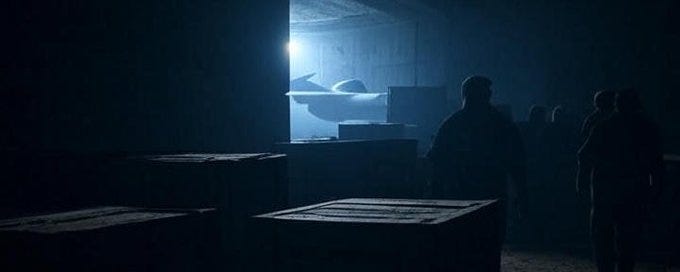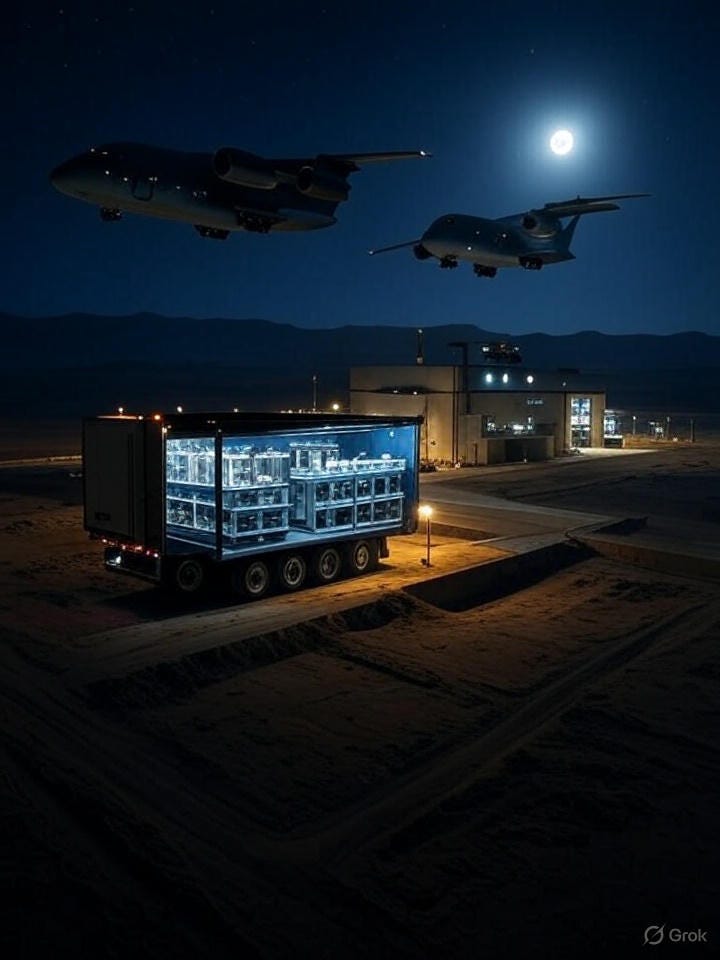Fordow Moved: A Response to @Amuse’s “Uranium Stayed Put” Narrative
June 29, 2025
Fordow Moved: A Response to @Amuse’s “Uranium Stayed Put” Narrative
By Julie Wade, J Auto Trading Strategies, LLC
June 30, 2025
JATS PT Points & Levels is a reader-supported publication. To receive new posts and support my work, consider becoming a free or paid subscriber.
Introduction
In light of the recent article Fordow Stood Still: Why Iran’s Uranium Stayed Put by @Amuse, a response is warranted—not for the sake of controversy, but for the sake of logic, physics, and the real limits of satellite imagery.
Let’s be clear: intelligence isn’t political. It doesn’t bend to what’s popular. Theories aren’t invalidated by consensus, nor validated by repetition or decibel level. The only thing that matters is what’s true—or, failing that, what’s most plausible.
1. Nightfall Hides Everything
The claim that “no secure uranium-handling trucks were seen” hinges entirely on satellite images captured during daylight hours.
This presumes that no exfiltration could occur at night—an assumption that collapses under scrutiny.
Commercial satellites typically pass over a site like Fordow just once or twice per day, leaving 12–18 hours of unmonitored darkness. Optical satellites can’t see in the dark. Infrared lacks precision. Military ISR isn’t omnipresent—and it certainly isn’t public.
So what happened between 8:00 PM and 5:00 AM from June 9 to June 12?
We don’t know.
And that’s exactly the point.
2. Dump Trucks and Decoys: A Strategic Distraction
The original article claims dump trucks were delivering cement to reinforce Fordow’s air shafts. Perhaps. But what if that cement wasn’t protection at all—it was performance?
Here’s a more plausible scenario:
The enriched uranium was removed under cover of night.
The trucks and bulldozers appeared the next morning—not to fortify, but to explain away what might be visible from space.
In intelligence parlance, this is a PSYOP framing tactic:
You perform visible activity after a covert operation—not to conceal it physically, but to give analysts a false narrative to latch onto.
Intelligence services have long used this exact pattern: conduct the real operation at night, then stage conspicuous daytime activity to mislead satellite analysts. Iran, in particular, has a deep history of deception—from concealing Natanz’s enrichment facility in 2002 to smuggling centrifuge components through shell companies (U.S. Treasury, 2019–2024). Iran has even staged decoy nuclear sites to fool satellites, as uncovered by IAEA in the 2000s.
In this light, cement trucks don’t signal transparency—they hint at narrative control.
Why did cement trucks suddenly arrive after years of inactivity? Why did that surface disruption coincide after the suspected nighttime exfiltration window and after Chinese military planes had come and gone?
Because visual noise creates analytical silence.
3. Logical Contradictions in the “Immobility” Argument
“Fordow is not a shipping warehouse,” the article says. True. But it’s also not a tomb.
Its purpose was protection, not permanent storage. And if Iran knew a strike was coming—and everyone agrees they did—then keeping 408.6 kg of 60% enriched uranium under a mountain about to be flattened would be suicidal.
@Amuse argues Fordow is “the safest place.” That’s a static view. But strategy is dynamic. If the site is compromised, you move.
What’s more secure:
Uranium under a collapsing mountain
Or uranium discreetly flown out under allied protection?
Let’s not forget: Fordow was obliterated. Satellite photos show mountain collapse. And yet—no fallout. That’s not “safer.” That’s empty.
4. The Absence of Convoys Is Not Proof of Absence
@Amuse emphasizes that no heavy uranium-handling trucks were observed—no convoys, no security, no escort vehicles.
But covert statecraft doesn’t operate on visible logistics.
Iran has a long record of using unconventional means to move nuclear assets—civilian vehicles, buried tunnels, and, in this case, possibly foreign military aircraft.
Let’s recall:
Chinese Y-20s landed in Iran between June 9–12.
No one knows what they delivered—or what they took.
Those same dates align with the exact exfiltration window.
Each Y-20 can carry up to 66 tons.
@Amuse cites “over 900 kg” of enriched uranium at Fordow, inflating the logistics required for exfiltration. But the IAEA’s last verified figure was 408.6 kg (May 31, 2025)—a payload that could fit in 15–20 shielded drums, requiring just one Y-20 transport, not a convoy of 18-wheelers.
Given that 408.6 kg of enriched uranium could be moved in 15–20 shielded containers totaling under 30 tons, a single Y-20 could have carried the entire payload.
And for all we know, those planes may have delivered the trucks themselves, executed the transport internally, and left with the cargo. Or, for all we know, the uranium didn’t leave Iran at all. It could have been moved a mile away, into an underground cache or secondary tunnel—beyond the satellite’s line of sight, but well outside the blast radius.
Covert operations don’t need to be elaborate. They just need to be unseen.
We don’t know what was on those aircraft.
But we do know they arrived, they left, and the uranium is missing.
5. The Media Played Its Part
Just before the strikes, Western outlets—including TIME Magazine—ran features on America’s bunker-busting capabilities.
Some dismissed it as bravado.
But to intelligence services, this wasn’t PR—it was a signal. A psychological pressure campaign. A warning designed to be seen by Iran and China.
And they likely understood the message: get it out now—while you still can.
Iran and China were watching. And they likely understood the signal.
And China’s incentive wasn’t abstract. Under its 2021 25-Year Strategic Agreement with Iran, China secured oil, infrastructure contracts, and nuclear collaboration. Preserving 408.6 kg of enriched uranium—leverage against the West—would align perfectly with China’s Belt and Road nuclear-security portfolio. With China expanding its nuclear arsenal, this uranium bolsters its strategic edge.
Y-20s weren’t just planes; they were lifeboats.
Iran had the motive (survival).
China had the means (airlift).
And both had the opportunity.
The idea that Iran “wouldn’t move it” because Fordow was secure falls apart when analyzed through strategic behavior and alliance logic.
6. Nuclear Silence: The Fallout No One’s Talking About
It’s been over a week since Operation Midnight Hammer—the most aggressive U.S. military action against a nuclear site since Osirak in 1981.
Fordow was struck. The site collapsed. The mountain above it was pulverized.
And yet—there is no fallout.
We are told Fordow contained 408.6 kg of uranium enriched to 60%—near weapons-grade. If true, the detonation of that material would have triggered:
Regional radiation alerts
Emergency IAEA reports
Satellite plume tracking
Ground contamination and global headlines
Instead, there’s nothing.
Could Fordow’s ruins have somehow contained the radiation? Unlikely. Bunker-busters are designed to destroy—not seal. They fragment hardened structures with penetrating force, leaving zero containment.
And where is the IAEA? Their May 31 report confirmed 408.6 kg of enriched uranium. Yet no post-strike inspection, no follow-up trace report, no confirmation of containment. As an IAEA Board member, China’s influence may explain this silence—no inspection, no trace, no answers.
Bunker-busters are designed to penetrate, detonate, and destroy—not preserve. If 408.6 kg of enriched uranium had been hit, IAEA would be on alert. But they aren’t.
Conclusion: The Real Question Isn’t What We Saw—It’s What We Didn’t
We didn’t see secure convoys—because they likely moved at night.
We didn’t see fallout—because the uranium likely wasn’t there.
We didn’t see Chinese exfiltration—because we weren’t supposed to.
Intelligence doesn’t sleep—and it doesn’t rely on daylight.
While others fixate on trucks and tunnels, the real question remains:
Where did the uranium go?
Because it’s not under that mountain anymore.
And if China moved it—using specialized nuclear-handling trucks flown in aboard Y-20s they already had on the ground (or delivered just in time), during the only hours we couldn’t see, right before the strike—then this wasn’t chaos.
It was choreography.
Whether it flew out in a Chinese Y-20, rolled out under civilian disguise, or was wheeled into a tunnel just a mile away—we don’t know.
And that’s the only honest place to start: not with false certainty, but with strategic suspicion grounded in logic, motive, and history.
Citations
@Amuse. (2025). Fordow Stood Still: Why Iran’s Uranium Stayed Put.
FlightRadar24. (2025, June 9–12). Y-20 Arrival Logs in Iran.
IAEA. (2025, May 31). Safeguards Report on Iran’s Uranium Holdings.
BBC. (2025, June 22). What We Know About US Strikes on Fordow.
TIME Magazine. (2025, May 21). Trump’s Sudden Saudi Trip Signals a Middle East on the Brink.
Nuclear Threat Initiative (NTI). China-Iran Nuclear Cooperation.
Council on Foreign Relations. (2021). China-Iran 25-Year Agreement.
UN Panel of Experts. (2010–2015). North Korea Sanctions Reports.
@Osinttechnical. (2025, June 13). X Post.
@Megatron_ron. (2025, June 14). X Post.
@AryJeay. (2025, June 13). X Post.
Author
Julie Wade
Managing Member, J Auto Trading Strategies, LLC
Copyright
© 2025, J Auto Trading Strategies, LLC. All rights reserved. The original text and analysis are the intellectual property of J Auto Trading Strategies, LLC. No part may be reproduced without prior written permission, except under fair use (17 U.S.C. § 107).
Disclaimer
This article is for informational purposes, based on publicly available sources, X posts, and user-provided data, as of June 30, 2025. J Auto Trading Strategies, LLC does not guarantee the accuracy of unverified claims, such as the Y-20 cargo or Chinese coordination. Inferences are speculative and intended to challenge prevailing narratives through plausible strategic frameworks. Readers are encouraged to reach their own conclusions.
JATS PT Points & Levels is a reader-supported publication. To receive new posts and support my work, consider becoming a free or paid subscriber.





